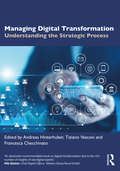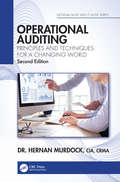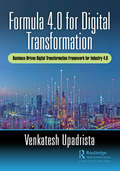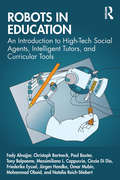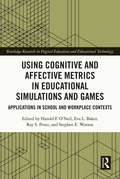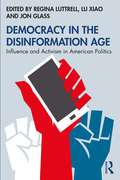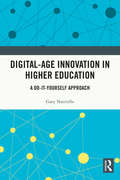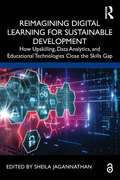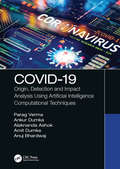- Table View
- List View
Managing Digital Transformation: Understanding the Strategic Process
by Andreas HinterhuberThis book provides practising executives and academics with the theories and best practices to plan and implement the digital transformation successfully. Key benefits: an overview on how leading companies plan and implement digital transformation interviews with chief executive officers and chief digital officers of leading companies – Bulgari, Deutsche Bahn, Henkel, Lanxess, L’Oréal, Unilever, Thales and others – explore lessons learnt and roadmaps to successful implementation research and case studies on the digitalization of small and medium-sized companies cutting-edge academic research on business models, organizational capabilities and performance implications of the digital transformation tools and insights into how to overcome internal resistance, build digital capabilities, align the organization, develop the ecosystem and create customer value to implement digital strategies that increase profits Managing Digital Transformation is unique in its approach, combining rigorous academic theory with practical insights and contributions from companies that are, according to leading academic thinkers, at the forefront of global best practice in the digital transformation. It is a recommended reading both for practitioners looking to implement digital strategies within their own organisations, as well as for academics and postgraduate students studying digital transformation, strategy and marketing.
Operational Auditing: Principles and Techniques for a Changing World (Internal Audit and IT Audit)
by Hernan MurdockOperational Auditing: Principles and Techniques for a Changing World, 2nd edition, explains the proven approaches and essential procedures to perform risk-based operational audits. It shows how to effectively evaluate the relevant dynamics associated with programs and processes, including operational, strategic, technological, financial and compliance objectives and risks. This book merges traditional internal audit concepts and practices with contemporary quality control methodologies, tips, tools and techniques. It explains how internal auditors can perform operational audits that result in meaningful findings and useful recommendations to help organizations meet objectives and improve the perception of internal auditors as high-value contributors, appropriate change agents and trusted advisors. The 2nd edition introduces or expands the previous coverage of: • Control self-assessments. • The 7 Es framework for operational quality. • Linkages to ISO 9000. • Flowcharting techniques and value-stream analysis • Continuous monitoring. • The use of Key Performance Indicators (KPIs) and Key Risk Indicators (KRIs). • Robotic process automation (RPA), artificial intelligence (AI) and machine learning (ML); and • Adds a new chapter that will examine the role of organizational structure and its impact on effective communications, task allocation, coordination, and operational resiliency to more effectively respond to market demands.
Operational Auditing: Principles and Techniques for a Changing World (Internal Audit and IT Audit)
by Hernan MurdockOperational Auditing: Principles and Techniques for a Changing World, 2nd edition, explains the proven approaches and essential procedures to perform risk-based operational audits. It shows how to effectively evaluate the relevant dynamics associated with programs and processes, including operational, strategic, technological, financial and compliance objectives and risks. This book merges traditional internal audit concepts and practices with contemporary quality control methodologies, tips, tools and techniques. It explains how internal auditors can perform operational audits that result in meaningful findings and useful recommendations to help organizations meet objectives and improve the perception of internal auditors as high-value contributors, appropriate change agents and trusted advisors. The 2nd edition introduces or expands the previous coverage of: • Control self-assessments. • The 7 Es framework for operational quality. • Linkages to ISO 9000. • Flowcharting techniques and value-stream analysis • Continuous monitoring. • The use of Key Performance Indicators (KPIs) and Key Risk Indicators (KRIs). • Robotic process automation (RPA), artificial intelligence (AI) and machine learning (ML); and • Adds a new chapter that will examine the role of organizational structure and its impact on effective communications, task allocation, coordination, and operational resiliency to more effectively respond to market demands.
Formula 4.0 for Digital Transformation: A Business-Driven Digital Transformation Framework for Industry 4.0
by Venkatesh UpadristaA staggering 70% of digital transformations have failed as per McKinsey. The key reason why enterprises are failing in their digital transformation journey is because there is no standard framework existing in the industry that enterprises can use to transform themselves to digital. There are several books that speak about technologies such as Cloud, Artificial Intelligence and Data Analytics in silos, but none of these provides a holistic view on how enterprises can embark on a digital transformation journey and be successful using a combination of these technologies. FORMULA 4.0 is a methodology that provides clear guidance for enterprises aspiring to transform their traditional operating model to digital. Enterprises can use this framework as a readymade guide and plan their digital transformation journey. This book is intended for all chief executives, software managers, and leaders who intend to successfully lead this digital transformation journey. An enterprise can achieve success in digital transformation only of it can create an IT Platform that will enable them to adopt any new technology seamlessly into existing IT estate; deliver new products and services to the market in shorter durations; make business decisions with IT as an enabler and utilize automation in all its major business and IT processes. Achieving these goals is what defines a digital enterprise -- Formula 4.0 is a methodology for enterprises to achieve these goals and become digital. Essentially, there is no existing framework in the market that provides a step-by-step guide to enterprises on how to embark on their successful digital transformation journey. This book enables such transformations. Overall, the Formula 4.0 is an enterprise digital transformation framework that enables organizations to become truly digital.
Formula 4.0 for Digital Transformation: A Business-Driven Digital Transformation Framework for Industry 4.0
by Venkatesh UpadristaA staggering 70% of digital transformations have failed as per McKinsey. The key reason why enterprises are failing in their digital transformation journey is because there is no standard framework existing in the industry that enterprises can use to transform themselves to digital. There are several books that speak about technologies such as Cloud, Artificial Intelligence and Data Analytics in silos, but none of these provides a holistic view on how enterprises can embark on a digital transformation journey and be successful using a combination of these technologies. FORMULA 4.0 is a methodology that provides clear guidance for enterprises aspiring to transform their traditional operating model to digital. Enterprises can use this framework as a readymade guide and plan their digital transformation journey. This book is intended for all chief executives, software managers, and leaders who intend to successfully lead this digital transformation journey. An enterprise can achieve success in digital transformation only of it can create an IT Platform that will enable them to adopt any new technology seamlessly into existing IT estate; deliver new products and services to the market in shorter durations; make business decisions with IT as an enabler and utilize automation in all its major business and IT processes. Achieving these goals is what defines a digital enterprise -- Formula 4.0 is a methodology for enterprises to achieve these goals and become digital. Essentially, there is no existing framework in the market that provides a step-by-step guide to enterprises on how to embark on their successful digital transformation journey. This book enables such transformations. Overall, the Formula 4.0 is an enterprise digital transformation framework that enables organizations to become truly digital.
Robots in Education: An Introduction to High-Tech Social Agents, Intelligent Tutors, and Curricular Tools
by Fady Alnajjar Christoph Bartneck Paul Baxter Tony Belpaeme Massimiliano Cappuccio Cinzia Di Dio Friederike Eyssel Jürgen Handke Omar Mubin Mohammad Obaid Natalia Reich-StiebertRobots in Education is an accessible introduction to the use of robotics in formal learning, encompassing pedagogical and psychological theories as well as implementation in curricula. Today, a variety of communities across education are increasingly using robots as general classroom tutors, tools in STEM projects, and subjects of study. This volume explores how the unique physical and social-interactive capabilities of educational robots can generate bonds with students while freeing instructors to focus on their individualized approaches to teaching and learning. Authored by a uniquely interdisciplinary team of scholars, the book covers the basics of robotics and their supporting technologies; attitudes toward and ethical implications of robots in learning; research methods relevant to extending our knowledge of the field; and more.
Robots in Education: An Introduction to High-Tech Social Agents, Intelligent Tutors, and Curricular Tools
by Fady Alnajjar Christoph Bartneck Paul Baxter Tony Belpaeme Massimiliano Cappuccio Cinzia Di Dio Friederike Eyssel Jürgen Handke Omar Mubin Mohammad Obaid Natalia Reich-StiebertRobots in Education is an accessible introduction to the use of robotics in formal learning, encompassing pedagogical and psychological theories as well as implementation in curricula. Today, a variety of communities across education are increasingly using robots as general classroom tutors, tools in STEM projects, and subjects of study. This volume explores how the unique physical and social-interactive capabilities of educational robots can generate bonds with students while freeing instructors to focus on their individualized approaches to teaching and learning. Authored by a uniquely interdisciplinary team of scholars, the book covers the basics of robotics and their supporting technologies; attitudes toward and ethical implications of robots in learning; research methods relevant to extending our knowledge of the field; and more.
Using Cognitive and Affective Metrics in Educational Simulations and Games: Applications in School and Workplace Contexts (Routledge Research in Digital Education and Educational Technology)
by Stephen E. Watson Harold F. O'Neil Eva L. Baker Ray S. PerezPresenting original studies and rich conceptual analyses, this volume explores how cognitive and affective metrics can be used to effectively assess, modify, and enhance learning and assessment outcomes of simulations and games used in education and training.The volume responds to the increasing use of computer-based simulations and games across academic and professional sectors by bringing together contributions from different research communities, including K-12 and postsecondary education, medical, and military contexts. Drawing on empirical results, the chapter authors focus on the design and assessment of educational simulations and games. They describe how quantitative and qualitative metrics can be used effectively to evaluate and tailor instructional resources to the cognitive and affective needs of the individual learner. In doing so, the volume enhances understanding of how games and simulations can intersect with the science of learning to improve educational outcomes. Given its rigorous and multidisciplinary approach, this book will prove an indispensable resource for researchers and scholars in the fields of educational assessment and evaluation, educational technology, military psychology, and educational psychology.
Using Cognitive and Affective Metrics in Educational Simulations and Games: Applications in School and Workplace Contexts (Routledge Research in Digital Education and Educational Technology)
by Harold F. O'NeilPresenting original studies and rich conceptual analyses, this volume explores how cognitive and affective metrics can be used to effectively assess, modify, and enhance learning and assessment outcomes of simulations and games used in education and training.The volume responds to the increasing use of computer-based simulations and games across academic and professional sectors by bringing together contributions from different research communities, including K-12 and postsecondary education, medical, and military contexts. Drawing on empirical results, the chapter authors focus on the design and assessment of educational simulations and games. They describe how quantitative and qualitative metrics can be used effectively to evaluate and tailor instructional resources to the cognitive and affective needs of the individual learner. In doing so, the volume enhances understanding of how games and simulations can intersect with the science of learning to improve educational outcomes. Given its rigorous and multidisciplinary approach, this book will prove an indispensable resource for researchers and scholars in the fields of educational assessment and evaluation, educational technology, military psychology, and educational psychology.
Democracy in the Disinformation Age: Influence and Activism in American Politics
by Regina Luttrell Lu Xiao Jon GlassIn this book established researchers draw on a range of theoretical and empirical perspectives to examine social media’s impact on American politics. Chapters critically examine activism in the digital age, fake news, online influence, messaging tactics, news transparency and authentication, consumers’ digital habits and ultimately the societal impacts that continue to be created by combining social media and politics. Through this book readers will better understand and approach with questions such as: • How exactly and why did social media become a powerful factor in politics? • What responsibilities do social networks have in the proliferation of factually wrong and hate-filled messages? Or should individuals be held accountable? • What are the state-of-the-art of computational techniques for measuring and determining social media's impact on society? • What role does online activism play in today’s political arena? • What does the potent combination of social media and politics truly mean for the future of democracy? The insights and debates found herein provide a stronger understanding of the core issues and steer us toward improved curriculum and research aimed at a better democracy. Democracy in the Disinformation Age: Influence and Activism in American Politics will appeal to both undergraduate and postgraduate students, as well as academics with an interest in areas including political science, media studies, mass communication, PR, and journalism.
Democracy in the Disinformation Age: Influence and Activism in American Politics
by Regina Luttrell Lu Xiao Jon GlassIn this book established researchers draw on a range of theoretical and empirical perspectives to examine social media’s impact on American politics. Chapters critically examine activism in the digital age, fake news, online influence, messaging tactics, news transparency and authentication, consumers’ digital habits and ultimately the societal impacts that continue to be created by combining social media and politics. Through this book readers will better understand and approach with questions such as: • How exactly and why did social media become a powerful factor in politics? • What responsibilities do social networks have in the proliferation of factually wrong and hate-filled messages? Or should individuals be held accountable? • What are the state-of-the-art of computational techniques for measuring and determining social media's impact on society? • What role does online activism play in today’s political arena? • What does the potent combination of social media and politics truly mean for the future of democracy? The insights and debates found herein provide a stronger understanding of the core issues and steer us toward improved curriculum and research aimed at a better democracy. Democracy in the Disinformation Age: Influence and Activism in American Politics will appeal to both undergraduate and postgraduate students, as well as academics with an interest in areas including political science, media studies, mass communication, PR, and journalism.
Digital-Age Innovation in Higher Education: A Do-It-Yourself Approach
by Gary NatrielloDigital-Age Innovation in Higher Education recounts the creation, development, and growth of an innovation unit within a major university. This single case study follows the development of the EdLab at the Gottesman Libraries of Teachers College, Columbia University, which was charged with developing new services and products at a time when digital technologies were markedly beginning to impact the sector. The major steps taken – recruiting staff in key skill areas, developing projects, collaborating across organizational lines, securing resources, delivering new services, and more – are covered in detail, illustrating the opportunities and challenges presented by innovation mandates in long-established organizations with stable operations and traditional academic values and practices.
Digital-Age Innovation in Higher Education: A Do-It-Yourself Approach
by Gary NatrielloDigital-Age Innovation in Higher Education recounts the creation, development, and growth of an innovation unit within a major university. This single case study follows the development of the EdLab at the Gottesman Libraries of Teachers College, Columbia University, which was charged with developing new services and products at a time when digital technologies were markedly beginning to impact the sector. The major steps taken – recruiting staff in key skill areas, developing projects, collaborating across organizational lines, securing resources, delivering new services, and more – are covered in detail, illustrating the opportunities and challenges presented by innovation mandates in long-established organizations with stable operations and traditional academic values and practices.
Reimagining Digital Learning for Sustainable Development: How Upskilling, Data Analytics, and Educational Technologies Close the Skills Gap
by Sheila JagannathanReimagining Digital Learning for Sustainable Development is a comprehensive playbook for education leaders, policy makers, and other key stakeholders leading the modernization of learning and development in their institutions as they build a high value knowledge economy and prepare learners for jobs that don't yet exist. Currently, nearly every aspect of human activity, including the ways we absorb and apply learning, is influenced by disruptive digital technologies. The jobs available today are no longer predicators of future employment, and current and future workforce members will need to augment their competencies through a lifetime of continuous upskilling and reskilling to meet the demands of the Fourth Industrial Revolution. This book features curated insights and real-world cases from thought leaders throughout the world and identifies major shifts in content formats, pedagogic approaches, technology frameworks, user and design experiences, and learner roles and expectations that will reshape our institutions, including those in emerging economies. The agile, lean, and cost-effective strategies proposed here will function in scalable and flexible bandwidth environments, enabling education leaders and practitioners to transform brick-and-mortar learning organizations into digital and blended ecosystems and to achieve the United Nation’s ambitious Sustainable Development Goals by 2030.
Reimagining Digital Learning for Sustainable Development: How Upskilling, Data Analytics, and Educational Technologies Close the Skills Gap
by Sheila JagannathanReimagining Digital Learning for Sustainable Development is a comprehensive playbook for education leaders, policy makers, and other key stakeholders leading the modernization of learning and development in their institutions as they build a high value knowledge economy and prepare learners for jobs that don't yet exist. Currently, nearly every aspect of human activity, including the ways we absorb and apply learning, is influenced by disruptive digital technologies. The jobs available today are no longer predicators of future employment, and current and future workforce members will need to augment their competencies through a lifetime of continuous upskilling and reskilling to meet the demands of the Fourth Industrial Revolution. This book features curated insights and real-world cases from thought leaders throughout the world and identifies major shifts in content formats, pedagogic approaches, technology frameworks, user and design experiences, and learner roles and expectations that will reshape our institutions, including those in emerging economies. The agile, lean, and cost-effective strategies proposed here will function in scalable and flexible bandwidth environments, enabling education leaders and practitioners to transform brick-and-mortar learning organizations into digital and blended ecosystems and to achieve the United Nation’s ambitious Sustainable Development Goals by 2030.
Software Testing: A Craftsman’s Approach, Fifth Edition
by Paul C. Jorgensen Byron DeVriesThis updated and reorganized Fifth edition of Software Testing: A Craftsman's Approach applies the strong mathematics content of previous editions to a coherent treatment of software testing. Responding to instructor and student survey input of previous editions, the authors have streamlined chapters and examples. The Fifth Edition: Has a new chapter on feature interaction testing that explores the feature interaction problem and explains how to reduce tests Uses Java instead of pseudo-code for all examples including structured and object-oriented ones Presents model-based development and provides an explanation of how to conduct testing within model-based development environments Explains testing in waterfall, iterative, and agile software development projects Explores test-driven development, reexamines all-pairs testing, and explains the four contexts of software testing Thoroughly revised and updated, Software Testing: A Craftsman’s Approach, Fifth Edition is sure to become a standard reference for those who need to stay up to date with evolving technologies in software testing. Carrying on the tradition of previous editions, it is a valuable reference for software testers, developers, and engineers.
Software Testing: A Craftsman’s Approach, Fifth Edition
by Paul C. Jorgensen Byron DeVriesThis updated and reorganized Fifth edition of Software Testing: A Craftsman's Approach applies the strong mathematics content of previous editions to a coherent treatment of software testing. Responding to instructor and student survey input of previous editions, the authors have streamlined chapters and examples. The Fifth Edition: Has a new chapter on feature interaction testing that explores the feature interaction problem and explains how to reduce tests Uses Java instead of pseudo-code for all examples including structured and object-oriented ones Presents model-based development and provides an explanation of how to conduct testing within model-based development environments Explains testing in waterfall, iterative, and agile software development projects Explores test-driven development, reexamines all-pairs testing, and explains the four contexts of software testing Thoroughly revised and updated, Software Testing: A Craftsman’s Approach, Fifth Edition is sure to become a standard reference for those who need to stay up to date with evolving technologies in software testing. Carrying on the tradition of previous editions, it is a valuable reference for software testers, developers, and engineers.
COVID-19: Origin, Detection and Impact Analysis Using Artificial Intelligence Computational Techniques
by Anuj Bhardwaj Parag Verma Ankur Dumka Alaknanda Ashok Amit DumkaThis book highlights progress in terms of Virus Biology and Infection Detection, Prevention, and Control, along with Screening, Testing, and Detection Techniques, that will provide learners and researchers (from basic to advanced) with the most innovative computer-driven methodologies for the fight against COVID-19. In addition, this book also covers the Pre- and Post-Impact of the COVID-19 Pandemic Crisis that will definitely provide useful content for researchers to think broadly about the analytical areas affected by COVID-19. This ultimately shows different paths to the same destination to help understand the nature of the COVID-19 pandemic and how to avoid it in the future.
COVID-19: Origin, Detection and Impact Analysis Using Artificial Intelligence Computational Techniques
by Parag Verma Ankur Dumka Alaknanda Ashok Amit Dumka Anuj BhardwajThis book highlights progress in terms of Virus Biology and Infection Detection, Prevention, and Control, along with Screening, Testing, and Detection Techniques, that will provide learners and researchers (from basic to advanced) with the most innovative computer-driven methodologies for the fight against COVID-19. In addition, this book also covers the Pre- and Post-Impact of the COVID-19 Pandemic Crisis that will definitely provide useful content for researchers to think broadly about the analytical areas affected by COVID-19. This ultimately shows different paths to the same destination to help understand the nature of the COVID-19 pandemic and how to avoid it in the future.
Building in Security at Agile Speed
by James Ransome Brook S.E. SchoenfieldToday's high-speed and rapidly changing development environments demand equally high-speed security practices. Still, achieving security remains a human endeavor, a core part of designing, generating and verifying software. Dr. James Ransome and Brook S.E. Schoenfield have built upon their previous works to explain that security starts with people; ultimately, humans generate software security. People collectively act through a particular and distinct set of methodologies, processes, and technologies that the authors have brought together into a newly designed, holistic, generic software development lifecycle facilitating software security at Agile, DevOps speed. —Eric. S. Yuan, Founder and CEO, Zoom Video Communications, Inc. It is essential that we embrace a mantra that ensures security is baked in throughout any development process. Ransome and Schoenfield leverage their abundance of experience and knowledge to clearly define why and how we need to build this new model around an understanding that the human element is the ultimate key to success. —Jennifer Sunshine Steffens, CEO of IOActive Both practical and strategic, Building in Security at Agile Speed is an invaluable resource for change leaders committed to building secure software solutions in a world characterized by increasing threats and uncertainty. Ransome and Schoenfield brilliantly demonstrate why creating robust software is a result of not only technical, but deeply human elements of agile ways of working. —Jorgen Hesselberg, author of Unlocking Agility and Cofounder of Comparative Agility The proliferation of open source components and distributed software services makes the principles detailed in Building in Security at Agile Speed more relevant than ever. Incorporating the principles and detailed guidance in this book into your SDLC is a must for all software developers and IT organizations. —George K Tsantes, CEO of Cyberphos, former partner at Accenture and Principal at EYDetailing the people, processes, and technical aspects of software security, Building in Security at Agile Speed emphasizes that the people element remains critical because software is developed, managed, and exploited by humans. This book presents a step-by-step process for software security that uses today’s technology, operational, business, and development methods with a focus on best practice, proven activities, processes, tools, and metrics for any size or type of organization and development practice.
Building in Security at Agile Speed
by James Ransome Brook S.E. SchoenfieldToday's high-speed and rapidly changing development environments demand equally high-speed security practices. Still, achieving security remains a human endeavor, a core part of designing, generating and verifying software. Dr. James Ransome and Brook S.E. Schoenfield have built upon their previous works to explain that security starts with people; ultimately, humans generate software security. People collectively act through a particular and distinct set of methodologies, processes, and technologies that the authors have brought together into a newly designed, holistic, generic software development lifecycle facilitating software security at Agile, DevOps speed. —Eric. S. Yuan, Founder and CEO, Zoom Video Communications, Inc. It is essential that we embrace a mantra that ensures security is baked in throughout any development process. Ransome and Schoenfield leverage their abundance of experience and knowledge to clearly define why and how we need to build this new model around an understanding that the human element is the ultimate key to success. —Jennifer Sunshine Steffens, CEO of IOActive Both practical and strategic, Building in Security at Agile Speed is an invaluable resource for change leaders committed to building secure software solutions in a world characterized by increasing threats and uncertainty. Ransome and Schoenfield brilliantly demonstrate why creating robust software is a result of not only technical, but deeply human elements of agile ways of working. —Jorgen Hesselberg, author of Unlocking Agility and Cofounder of Comparative Agility The proliferation of open source components and distributed software services makes the principles detailed in Building in Security at Agile Speed more relevant than ever. Incorporating the principles and detailed guidance in this book into your SDLC is a must for all software developers and IT organizations. —George K Tsantes, CEO of Cyberphos, former partner at Accenture and Principal at EYDetailing the people, processes, and technical aspects of software security, Building in Security at Agile Speed emphasizes that the people element remains critical because software is developed, managed, and exploited by humans. This book presents a step-by-step process for software security that uses today’s technology, operational, business, and development methods with a focus on best practice, proven activities, processes, tools, and metrics for any size or type of organization and development practice.
Inspiring Remote Tech Teams: Keys to Leadership and Purposeful Performance
by Hubbert SmithFor me and other tech people, leaders, and members of remote teams, we will be awakened by all the fantastic hands-on hints, best practices, and guiding principles based on solid ground that Hubbert provides in Inspiring Remote Tech Teams. We will be better prepared and better equipped to both contribute and lead efficiently in the digital economies that shape the future of our world. — Thomas DiGiacomo, President of Engineering and Innovation at SUSE Inspiring Remote Tech Teams is a trail map to building effective teams and organizations—now, as world health dictates remote work, and in the future, as global talent pools contribute to our digital economy. Humans are wired to be social, and world events require social distancing from our office community. The absence of "community" triggers primitive brain responses. These instinctual responses of survival, social belonging, and the power of story all profoundly surface during our reaction as we adjust to remote work. This trail map for team leaders improves team execution despite physical separation. The book covers simple neuroscience as it applies to our "separation." It is a hands-on guide to maintaining and improving teamwork while working remotely. It is also a hands-on guide at the intersection of teams + remote + laymen’s neuroscience to create a positive sense of enthusiasm, engagement, and contribution, even when working apart. Remote teams, now and for the future, are the pathway to using global talent effectively. This book examines the combination of the "hard skills" of tech team project management and the "soft skills" of healthy distributed teams: remote offices, sales offices, partners, suppliers, customers, and teams engaging global talent pools. Practical examples and best practices offer hands-on methods to use neuroscience to help teams be their best, to improve collaboration, and to deliver consistent team results.
Inspiring Remote Tech Teams: Keys to Leadership and Purposeful Performance
by Hubbert SmithFor me and other tech people, leaders, and members of remote teams, we will be awakened by all the fantastic hands-on hints, best practices, and guiding principles based on solid ground that Hubbert provides in Inspiring Remote Tech Teams. We will be better prepared and better equipped to both contribute and lead efficiently in the digital economies that shape the future of our world. — Thomas DiGiacomo, President of Engineering and Innovation at SUSE Inspiring Remote Tech Teams is a trail map to building effective teams and organizations—now, as world health dictates remote work, and in the future, as global talent pools contribute to our digital economy. Humans are wired to be social, and world events require social distancing from our office community. The absence of "community" triggers primitive brain responses. These instinctual responses of survival, social belonging, and the power of story all profoundly surface during our reaction as we adjust to remote work. This trail map for team leaders improves team execution despite physical separation. The book covers simple neuroscience as it applies to our "separation." It is a hands-on guide to maintaining and improving teamwork while working remotely. It is also a hands-on guide at the intersection of teams + remote + laymen’s neuroscience to create a positive sense of enthusiasm, engagement, and contribution, even when working apart. Remote teams, now and for the future, are the pathway to using global talent effectively. This book examines the combination of the "hard skills" of tech team project management and the "soft skills" of healthy distributed teams: remote offices, sales offices, partners, suppliers, customers, and teams engaging global talent pools. Practical examples and best practices offer hands-on methods to use neuroscience to help teams be their best, to improve collaboration, and to deliver consistent team results.
Creating Transformative Online Communities in Higher Education
by Patrick R. DempseyCreating Transformative Online Communities in Higher Education provides a practical approach for building authentic learning experiences into the design and delivery of online teaching and learning systems. Combining three conceptually related ideas—complexity theory, transformative learning, and the Community of Inquiry—this novel, highly applicable framework enables instructors to create compelling virtual learning experiences for students. As higher education faculty, instructional designers, and graduate students shift from presenting information to creating experiences, the book offers an evidence-based disruption of the current thinking on and practice of course design.
Creating Transformative Online Communities in Higher Education
by Patrick R. DempseyCreating Transformative Online Communities in Higher Education provides a practical approach for building authentic learning experiences into the design and delivery of online teaching and learning systems. Combining three conceptually related ideas—complexity theory, transformative learning, and the Community of Inquiry—this novel, highly applicable framework enables instructors to create compelling virtual learning experiences for students. As higher education faculty, instructional designers, and graduate students shift from presenting information to creating experiences, the book offers an evidence-based disruption of the current thinking on and practice of course design.
